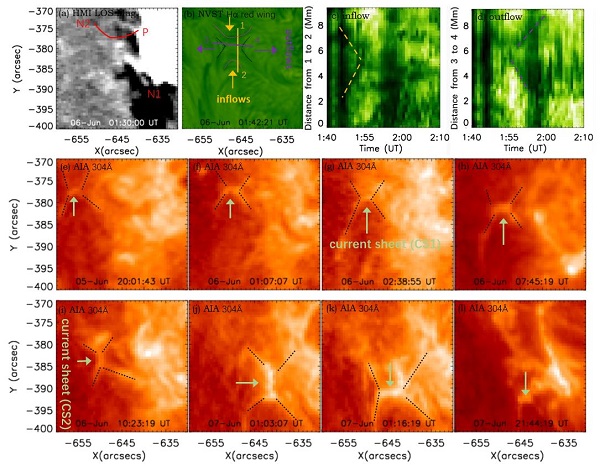Researchers from the Fuxian Lake Solar Observatory of Yunnan Observatories, Chinese Academy of Sciences (CAS) and Yunnan Normal University have clearly observed the formation of an intermediate filament caused by small-scale oscillation magnetic reconnection.
The results were recently published in The Astrophysical Journal. This work was done in collaboration with SUN Xia and LIANG Hongfei of Yunnan Normal University and YAN Xiaoli (corresponding author) of Yunnan Observatories, and others.
Magnetic reconnection is a physical process of converting magnetic energy into kinetic and thermal energy, which can change the topology of magnetic field. Many observational evidences of magnetic reconnection have been reported, such as current sheets, bright cusp-shaped structures, plasma inflow/outflow, and so on. However, direct observations of magnetic reconnection leading to the formation of filament are still very rare.
Using high-resolution data from the 1-meter New Vacuum Solar Telescope (NVST) at the Fuxian Lake Solar Observatory, combined with extreme ultraviolet (EUV) data from the Solar Dynamics Observatory (SDO) and the Global Oscillation Network Group (GONG) data, researchers analyzed the filament formation due to small-scale magnetic reconnection that occurred in the active region 12765 on June 5, 2020. They found that the filament and the surrounding magnetic loops are in close proximity to each other, followed by magnetic reconnection between them.
The formed current sheets were found almost relatively perpendicular current sheets, which are called oscillatory reconnection, and eventually plasma is injected into the interior of the filament, leading to the formation of the filament. Physical quantities such as the velocity, mass, and kinetic energy of the material entering the filament were also calculated. The injected mass from the magnetic reconnection is consistent with the estimated mass of the filament.
This research is supported by the National Natural Science Foundation of China, the Science Foundation of Yunnan Province, the Key Laboratory of Solar Physics and Space Science of Yunnan Province, the Science Foundation for Distinguished Young Scholars of Yunnan Province, the Talent Program of Western China Light of the Chinese Academy of Sciences, and so on.

a) The HMI magnetogram shows the magnetic field configuration of active region 12765. The solid red line represents the surrounding loops. The polarity of the north footpoint of the filament is indicated by N1, and the two polarities of the surrounding loops are indicated by N2 and P, respectively. (b)-(d) Reconnected evidence of material injection observed by the NVST from 01:40 UT to 02:10 UT. The dotted pink and black lines represent the magnetic loops and the cusp-shaped structure. Yellow/purple arrow, solid yellow/purple line and dotted yellow/purple line represent inflow/outflow direction, inflow/outflow position of time-slice and inflow/outflow, respectively. (e)-(i) Evidence of magnetic reconnection in other time periods observed in AIA 304 Å images. The green arrow and black dotted line represent the position of the current and the bright cusp-shaped structure.
Contact:
YAN Xiaoli
Yunnan Observatories, CAS
Email: yanxl@ynao.ac.cn